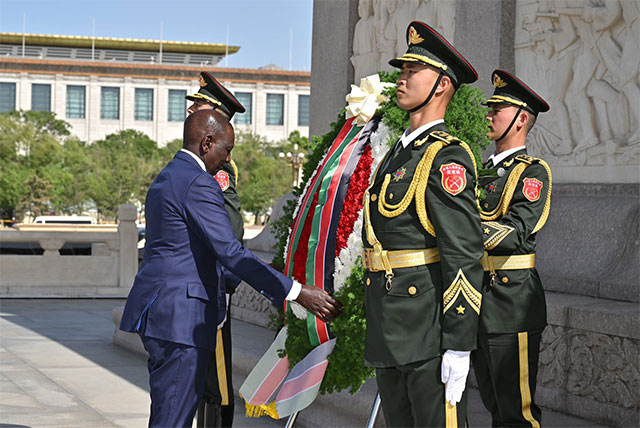
Beyond physical infrastructure, Ruto’s engagement with China may also touch on trade facilitation and regional value chains. Uganda and Kenya share an interest in expanding their agricultural exports, a sector in which China has increasingly shown interest as it seeks food security partnerships abroad.
COMMENT | Stephen Ndegwa | Kenya President William Ruto’s state visit to China from April 22 to April 26 comes at a crucial time for East Africa, particularly for Uganda, whose fortunes remain deeply intertwined with Kenya’s economic and infrastructural trajectories. As the region’s largest economy and a key transport corridor, Kenya’s diplomatic engagements with Beijing invariably carry significant implications for its landlocked neighbour. Should President Ruto’s mission yield substantive outcomes, the ripple effect on Uganda could be both immediate and long-term, particularly in areas of trade facilitation, infrastructure development, and access to regional and global markets.
Kenya and Uganda share not only borders but economic destinies. Both are central players in the Northern Corridor, a vital artery for trade that stretches from the port of Mombasa through Nairobi, Kampala, and into the heart of the Great Lakes region. China has played a critical role in shaping this corridor, having invested billions of dollars in roads, railways, and energy projects that criss-cross both countries.
With Kenya as the coastal gateway, Uganda’s dependence on the seamless functioning of Kenyan ports, railways and highways is absolute. Any success in Ruto’s negotiations with the Chinese leadership could pave the way for renewed or extended support for infrastructure upgrades, which would naturally benefit Ugandan traders and industries reliant on Kenyan facilities for import and export.
One of the more likely outcomes of Ruto’s visit is a renewed push for the extension of the Standard Gauge Railway (SGR) from Naivasha towards Malaba, on the border with Uganda. While the SGR has not yet met its transformative potential within Kenya, an extension towards Uganda, and eventually to Kampala and beyond, would significantly lower the cost of transporting goods across East Africa.
Uganda has long expressed commitment to the SGR project, albeit cautiously, pending Kenya’s completion of its segment. Should China commit to financing or co-financing the continuation of the railway, both countries stand to benefit from enhanced logistics, reduced travel times, and increased investor confidence. For Uganda, whose economy relies heavily on the timely movement of fuel, construction materials, and manufactured goods, the economic dividend would be substantial.
Beyond physical infrastructure, Ruto’s engagement with China may also touch on trade facilitation and regional value chains. Uganda and Kenya share an interest in expanding their agricultural exports, a sector in which China has increasingly shown interest as it seeks food security partnerships abroad. Harmonising standards, opening up Chinese markets to East African goods, and investing in agro-processing facilities could uplift rural economies across both countries. If Kenya secures such arrangements, Uganda is likely to benefit through shared trade frameworks under the East African Community protocols, as well as through joint ventures that transcend borders.
In the realm of digital infrastructure and technology, both Kenya and Uganda have become fertile ground for Chinese investment, particularly in telecommunications and e-commerce. Kenya’s digital economy has grown rapidly, attracting interest from Chinese firms in fintech, mobile services and smart city concepts. Uganda, while trailing slightly behind, could benefit from joint digital infrastructure projects and knowledge transfer if Ruto’s visit catalyses broader regional cooperation in this area.
Given that both governments have shown interest in developing e-governance platforms and national data systems, a shared approach to Chinese-supported digital frameworks could foster regional integration and data-driven development.
Kenya and Uganda also share a common diplomatic language when it comes to their engagement with China. Both countries favour a pragmatic, non-confrontational approach that emphasises development financing and mutual respect. They have resisted pressures to distance themselves from China, opting instead to deepen ties based on infrastructure, trade and strategic investment. This alignment increases the chances of Uganda piggybacking on any major deals Kenya secures, especially those with a regional dimension.
Finally, Ruto’s visit may encourage renewed discussions around regional financing models backed by China, such as public-private partnerships that pool resources from multiple East African nations. Uganda, with its relatively lower debt distress compared to some neighbours, is well positioned to be part of such models, especially in energy, transport and industrial park development. If Ruto can secure China’s interest in broader regional cooperation rather than a purely bilateral approach, Uganda could emerge a major beneficiary.
Given the deep socio-economic ties and infrastructural dependencies between the two countries, success in Beijing could translate into tangible improvements in Uganda’s connectivity, trade competitiveness and investment environment. As China continues to recalibrate its Belt and Road Initiative to emphasise sustainability and regional integration, Uganda and Kenya stand on common ground, ready to take the next leap forward, together.
*****
The writer is a Nairobi-based communications specialist with a keen interest in African foreign policy and China-Africa relations.
 The Independent Uganda: You get the Truth we Pay the Price
The Independent Uganda: You get the Truth we Pay the Price



